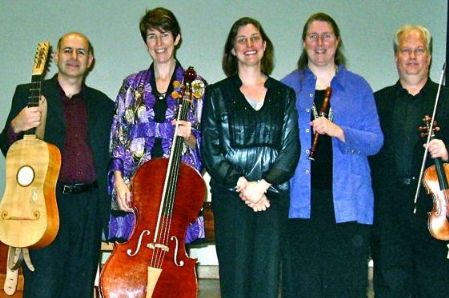|
Symphony
FROM THE NEW WORLD TO THE OLD WORLD
by Peter Lert
Saturday, June 14, 2025
Chamber
MC2 DUO RECITAL CLOSES 222'S SEASON
by Terry McNeill
Saturday, June 14, 2025
Choral and Vocal
CANTIAMO SONOMA'S LUSCIOUS A CAPELLA SINGING IN SEASON ENDING CONCERT
by Pamela Hicks Gailey
Sunday, June 8, 2025
Symphony
SRS SEASON ENDS WITH RESOUNDING TA-TA-TA-BANG
by Terry McNeill
Sunday, June 1, 2025
Symphony
YOUTHFUL VIRTUOSITY ON DISPLAY AT USO'S MAY CONCERTS
by Peter Lert
Saturday, May 17, 2025
Symphony
MYSTICAL PLANETS AND LIVELY GERSHWIN ORTIZ AT FINAL SRS CONCERT
by Peter Lert
Sunday, May 4, 2025
Symphony
VSO'S CONCERT MUSIC OF TIME, MUSIC OF PLACE
by Peter Lert
Sunday, April 27, 2025
VOCAL ELEGANCE AND FIRE AT THE 222'S RECITAL APRIL 26
by Pamela Hicks Gailey
Saturday, April 26, 2025
CANTIAMO SONOMA SINGS AN INSPIRED GOOD FRIDAY MOZART REQUIEM CONCERT
by Pamela Hicks Gailey
Friday, April 18, 2025
DRAMATIC SHOSTAKOVICH SYMPHONY CLOSES PHILHARMONIC'S 25TH SEASON
by Terry McNeill
Sunday, April 13, 2025
|
 |
 Ensemble Vermillian (l to r): Simms, Krumdieck, Heater, Blaker and Wilson |
VERMILLIAN'S INSTRUMENTAL VIRTUOSITY HIGHLIGHTS RARE BIBER AND COLISTA WORKS
by Joanna Bramel Young
Saturday, January 7, 2012
A top quality baroque concert was presented at Santa Rosa’s Waldorf School Jan. 7 featuring the Ensemble Vermillian. Among the five performers at least nine instruments were used, and the variety of this instrumentation brought 17th and 18th Century musical gems to life.
The Vermillian in the Sophia Hall event, hosted by Waldorf teacher and musician Isabel Wundsam, included Frances Blaker (soprano, alto and tenor recorders); David Wilson, baroque violin; Barbara Blaker Krumdieck (baroque cello); Katherine Heater (harpsichord and small organ); and William Simms playing the baroque guitar and theobro. The theobro is a large lute with bass strings extending nearly six feet in length.
Except for a Bach Flute Sonata, BWV 1030, the program’s works were not well known. Through transcription, common in the baroque era, the group has made rarely-heard pieces their own, and therefore accessible to modern audiences.
Lelio Colista’s Symphonia opened the concert and the bright little soprano recorder balanced well with the ensemble playing. Typical of 17th Century Italian sonatas, one movement gracefully and seamlessly merged into another. In this work the harpsichord, cello and theorbo were a tightly linked unit, supporting the brilliant soloistic duet between recorder and violin.
The Bach was originally scored for flute, obligato harpsichord and basso continuo, and in Bach’s original work the right hand of the harpsichord player matches the flute in its solo passages. The left hand supports the bass line. In her transcription Ms. Blaker scored the flute for alto recorder and gave the usual right-hand soloistic harpsichord part to the violin. This relegated the harpsichord to a continuo part with the cello. Ms. Heater had to invent a right hand part for her elegant instrument. In the long opening Andante this reviewer would have preferred hearing Bach’s version, without the violin, as the latter’s part sounded fragmented and tended to overpower the recorder. The hauntingly beautiful Largo e dolce, the second movement, was played as Bach wrote it – just the recorder and harpsichord. This movement allowed the harpsichord to be cleanly heard, “singing” in a most expressive and lyrical mode. The last Presto – Allegro is a rollicking gigue with daunting repeated hesitations and cross rhythms, and it worked extremely well with the added violin.
Ms. Blaker announced to the audience that the Bach Sonata was the “main course,” but the “sorbet” was to come: a wonderful short sonata by Antonio Bertali. It was the highlight of the program with the guitar, harpsichord and cello accompanying the soprano recorder and violin. There were brilliant and contrasting ornamented parts with the guitar strumming adding strong rhythms. The cello also got into the mix by adding sinuous runs to the exciting whole.
Mr. Wilson demonstrated fine violin technique in one of Biber’s “Rosary Sonatas.” A renowned violinist in his day, Biber gave each of his 15 Rosary works a different tuning, and here Mr. Wilson tuned his violin to an altered tuning, called scordatura. With the organ, cello and theorbo accompanying, the work was a set of variations on a theme, and Mr. Wilson performed exuberant ornaments while the continuo supported with a driving four-bar descending ostinato bass.
All of the Vermillian players demonstrated great facility with their instruments and through research, tight ensemble and virtuoso playing brought less familiar repertoire to the appreciative audience.
|

